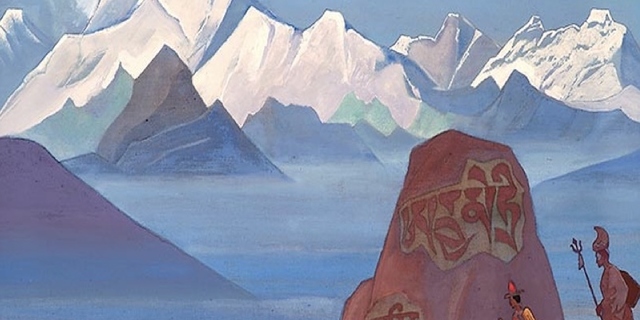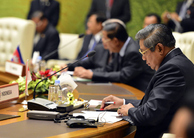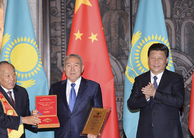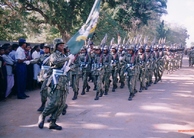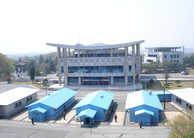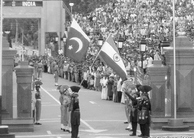|
Asia (tagged articles)
The keyword Asia is tagged in the following 34 articles.
2022, Vol. 14 No. 02
India was ruled by the Timurid-Mughal dynasty from 1526 to 1857. This period is mainly recognised for its art and architecture. The Timurid-Mughals also promoted knowledge and scholarship. Two of the Mughal emperors, Babur and Jahangir, wrote their... Read Article »
2021, Vol. 13 No. 10
Suicide is legal in almost every country, but places where euthan Asia is permitted remain in the minority (Mishara and Weisstub 2016). In many legislatures, suicide is not a criminal act. It is, however, a criminal act for you to assist me in this... Read Article »
2021, Vol. 13 No. 02
Nicholas Roerich was inspired by the mystical concept of “Shambhala”—a utopian expanse of endless truth, knowledge and peace—and his paintings of Asia in the period 1923-1947 attempt to portray the pursuit of this utopian... Read Article »
2020, Vol. 12 No. 10
This paper explores the meaning and implications of “ Asian” in the context of American restaurant menus. I determine what kind of language in dish descriptions, specifically ingredients and adjectives, indexes a restaurant or dish as... Read Article »
2019, Vol. 11 No. 12
South Asian women in particular are not only vulnerable to domestic violence, but exceptionally vulnerable to underreporting of domestic violence. The problem compounds itself by making it difficult not only to quantify the issue, but also harder... Read Article »
2017, Vol. 10 No. 2
The global network of the Islamic State of Iraq and Syria (ISIS), also known as Daesh,2 is expanding rapidly. Southeast Asia is especially vulnerable because of its large Muslim population and its history of extremist groups. In fact, some experts... Read Article »
2017, Vol. 9 No. 03
World War II ranks among the deadliest military conflicts in history. From 1939-1945, the estimated number of casualties worldwide exceeded 60 million.[1] The United States suffered military fatalities in excess of four hundred thousand, and the... Read Article »
2016, Vol. 10 No. 1
Economic regionalism has been an observable phenomenon worldwide. Many countries around the world pursue some degree of economic integration with neighbouring countries, in the hopes of capitalizing on the benefits of such an arrangement. At the... Read Article »
2016, Vol. 9 No. 1
Founded in 1967, the Association of Southeast Asian Nations (ASEAN) is one of the most prominent intergovernmental organizations in Asia. ASEAN's main achievement has been to unite ten countries in Southeast Asia through shared goals of regional... Read Article »
2016, Vol. 9 No. 1
The New Silk Road, formally termed the Silk Road Economic Belt and also known as the "One Belt, One Road," was first proposed by China's President Xi Jinping during his 2013 visit to Central Asia. This initiative aims to revive the historical vitality... Read Article »
2015, Vol. 7 No. 09
Dr. Timothy Quill made headlines in the fields of patient rights and euthan Asia when he published “Death and Dignity” in the New England Journal of Medicine (1991). In the articlce, Quill described his long-term patient, Diane, who had... Read Article »
2015, Vol. 8 No. 2
America’s record of engagement in Central Asia[i] has been extensive during its post-9/11 era of adventurism. Between its vast military infrastructure and its explosive expansion of new commercial and security networks, the US has invested... Read Article »
2014, Vol. 7 No. 2
Since the start of the Sri Lankan Civil War in 1983, Tamil women have occupied a key role in the conflict. In the struggle for the anticipated state of Tamil Eelam, the socio-cultural role of women underwent, and continues to undergo, a radical... Read Article »
2014, Vol. 7 No. 2
The balance of terror created by the presence of weapons of mass destruction (WMDs) on the Korean peninsula has escalated the sense of uncertainty in East Asia, jeopardizing both the region’s security and progress towards political and economic... Read Article »
2014, Vol. 7 No. 2
In the ultimate years of the Soviet Union, as the liberalizations introduced by perestroika and glasnost took full effect, the nationalistic convictions of historically discriminated territories within the Russian and Central Asian region began... Read Article »
2013, Vol. 3 No. 1
While the enslavement of humans has been occurring even before the dawn of written history, today's form of slavery occurs on an unprecedented scale in both scope and reach. This work attempts to understand the most vulnerable sectors of population... Read Article »
2013, Vol. 6 No. 2
Mr. Mahbubani is a Professor of Public Policy and Dean of the Lee Kwan Yew School of Public Policy at the National University of Singapore. He is the former Permanent Secretary at the Foreign Ministry, and later served as Singapore Permanent Representative... Read Article »
2013, Vol. 6 No. 2
Regionalism, as Edward Mansfield describes, usually involves policy coordination through formal institutions within a region.1 Although there are conceptual debates surrounding what a region is and what regionalism is, empirically speaking one would... Read Article »
2013, Vol. 5 No. 03
The Soviet nationality policy for Central Asia in the early twentieth century was an acceleration of the processes of modernization that the Russian Empire had already begun. However, building socialism in a region where no working class existed... Read Article »
2012, Vol. 4 No. 09
Nepal is a small developing country in South Asia, bordered by China to the north and India to the south, east and west. With a total land area of 56,827 square miles, the country is predominantly mountainous with more than 80% of the total area... Read Article »
2012, Vol. 4 No. 08
The relationship between trade and conflicts between countries in South Asia is important to examine because of the rising prominence of this region of the world. Security issues are of utmost concern when considering the damaging effects that armed... Read Article »
2012, Vol. 4 No. 04
Russia and Iran have a long history of being geographic neighbours, rivals, competitors and partners - a history which has coined mutual expectations, stereotypes and interactions. Still present in the Iranian collective memory, Tsarist Russia expanded... Read Article »
2011, Vol. 3 No. 09
My living room piano speaks loudly through its stillness. Drawn to the haunting beauty of its polished black wood, visitors would constantly inquire about the dust on its keys. As its former player, I was expected to replace the quiet with a symphony... Read Article »
2011, Vol. 3 No. 08
One of the fastest growing medical phenomena is that of human euthan Asia. No matter what the argument or the entity involved, the common question seems to be whether or not the act of human euthan Asia is an ethically acceptable practice. Frequently... Read Article »
2011, Vol. 3 No. 05
Despite the increasing number of states that have ratified binding international human rights treaties, human rights abuses continue unabated. The persistence of rights abuses cast doubt on the efficacy of human rights treaties. This paper empirically... Read Article »
2011, Vol. 4 No. 2
Seymour Martin Lipset's, "the more well-to-do a nation, the greater chances that it will sustain democracy,"1 has set off over five decades of intense debate over the conditions most conducive to democratic transition and establishment. Variations... Read Article »
2011, Vol. 3 No. 04
The Islamic Republic of Iran today sits at the crossroads of Asia between the Middle East and Central Asia. This inherently places it in very close proximity to over half of the world's known energy reserves both in the form of petroleum and natural... Read Article »
2010, Vol. 4 No. 1
Drawing from the concept of national identity in the Constructivist School of International Relations, this paper sheds light on the interaction between identity politics and pan- Asian regionalist vision in South Korea today by examining how competing... Read Article »
2010, Vol. 2 No. 06
If Japan was a person, it would be an exceptionally wealthy yet rapidly aging individual, who, for two decades, had been struck by illness. One might therefore find it unexpected for this person to be busily working on constructing the new face... Read Article »
2010, Vol. 2 No. 02
In “Amor de lejos: Latino (Im)migration Literatures,” B.V. Olguin writes, “Latino/a (im)migration narratives…often illustrate the traumatic aspects of displacement by focusing in part on how immigration, migration, exile... Read Article »
2010, Vol. 2 No. 02
Anne Fadiman’s The Spirit Catches You and You Fall Down: A Hmong Child, Her American Doctors, and the Collision of Two Cultures is a non-fiction exploration of culture and medicine that tells the tragic story of the Lee family and their daughter... Read Article »
2009, Vol. 1 No. 10
Language use is a major factor in defining one’s cultural identity. People learn slang, lingo, jargon, idiomatic phrases, and other language tools, and with them participate in a cultural, social environment in which they can thrive. For ethnic... Read Article »
2009, Vol. 1 No. 10
Nearly eight years into the war, the security situation in Afghanistan appears to be deteriorating at an increasingly fast past. Areas that were previously secured have been retaken by militants; significant increases in civilian casualties, caused... Read Article »
2008, Vol. 1 No. 2
South Asia is not in itself the primary zone of interest of China. However, China has since long used the region’s dynamics to achieve some of its most important strategic goals. Moreover, since India wishes to establish “its rightful... Read Article »
Expedited Article Review
Submit an article and get a decision fast.
If you need a fast decision, INQUIRIES Journal offers expedited processing of your submission for a small fee. Depending on the expedited review option you choose, you can receive a decision in as few as 5-days.
In addition to a shorter review period, the fee supports the journal's continued operation and open-access publishing model. Standard submissions are always free. Submit Now » - Submit an Article to Inquiries Journal -
|



